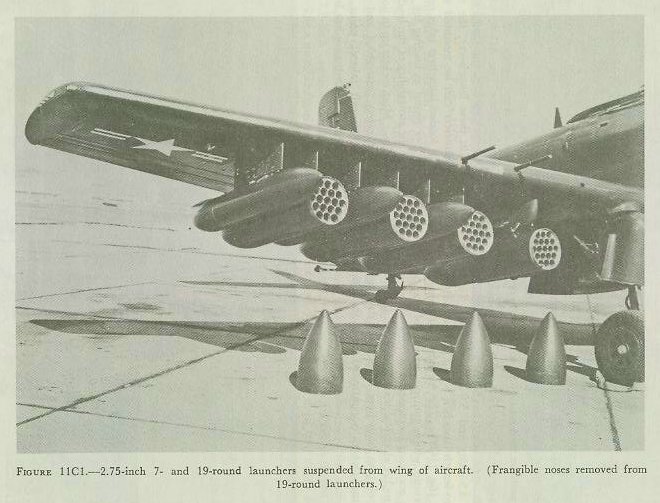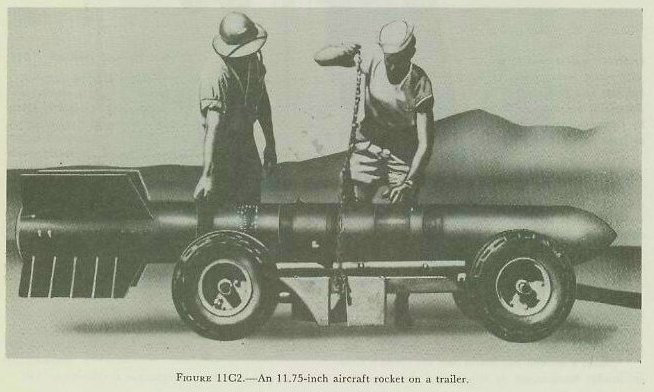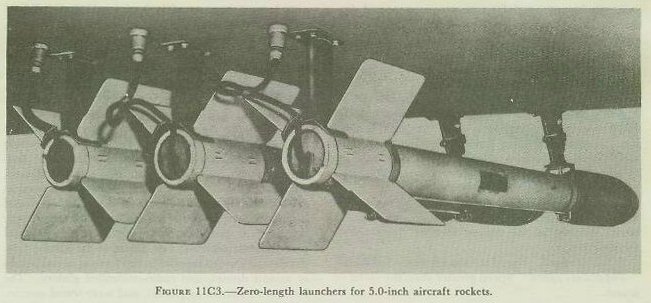| GENE SLOVER'S US NAVY PAGES NAVAL ORDNANCE AND GUNNERY VOLUME 1, NAVAL ORDNANCE CHAPTER 11 ROCKETS AND GUIDED MISSILES |
| HOME INDEX Chapter 11 Rockets and Guided Missiles A. Rockets and the rocket principle B. Rockets fired from surface craft C. Aircraft rockets D. Guided missiles |
| C. Aircraft Rockets 11C1. Rockets and aircraft Aircraft rockets have been used primarily as forward-firing weapons, which supplement or take the place of forward-firing guns. The virtual absence of recoil in launching aircraft rockets makes possible the use of lightweight gear for such launching, and introduces no stresses inimical to the plane’s structures. A modern rocket-firing plane armed with 5.0-inch rockets can deliver one salvo comparable to that of a destroyer, and a squadron of F9F planes carrying 11.75-inch rockets can fire a salvo similar to that of a cruiser division. In making such a comparison, however, it must be remembered that the ships can keep on firing, whereas the planes must return to base after delivering their pay loads. Generally speaking, rockets provide superior firepower with minimum added weight. The pay load of a rocket is less than that of a comparable bomb, but the rocket presents advantages related to accuracy of fire and greater penetration. Rocket velocity is augmented by the velocity of the launching plane, with the result that actual velocities attained approach those of comparable projectiles, and this accuracy increases as the speed and stability of the aircraft at the time of release are increased. In antisubmarine use, the underwater trajectory of rockets is predictable, and this fact can be used to great advantage. 11C2. Aircraft rocket types Basic types of aircraft rocket include a 2.25-inch training rocket (SCAR), the 2.75-inch air-to-air “Mighty Mouse” (FFAR), the 5.0-inch aircraft rocket (5.0-inch AR), the 5.0-inch high-velocity rocket (HVAR), the 7.2-inch antisubmarine rocket (VAR), and the 11.75-inch aircraft rocket (11.75-inch AR) or “Tiny Tim.” The “Mighty Mouse” is a 2.75-inch contact-fuzed air-to-air rocket with folding fins that open on launching. It is small enough to be carried in quantity, but with a direct hit, one round can destroy a plane. The rockets are carried in streamlined cylindrical jettisonable launchers, carrying up to 19 rockets each, which can be suspended under the wing of an aircraft. (Fig. 11C1.) The rockets are “ripple-fired” through the frangible nose of the launcher in quick succession. The 5.0-inch high-velocity rocket (1,375 fps) can penetrate 6 feet of concrete. It is used against ships, pillboxes, locomotives, and tanks. Its head is a 5-inch Mark 35 common projectile, with nose and base fuzes and a 7.9-pound charge of TNT. The propellant is a 24-pound grain of ballistite. The 11.75-inch rocket (fig. 11C2) attains a velocity of 800 fps and has the explosive effect of a 500-pound bomb. Its head contains about 150 pounds of TNT. The motor contains 148 pounds of ballistite. |
 |
 |
 |
| 11C3. Suspension and launching of aircraft rockets The conventional aircraft launcher for forward firing is the post type, which has been employed to launch 2.25-inch, 3.5-inch, and 5.0-inch rockets. In the Mark 5 zero-length launcher, a pair of posts supports the rocket, (fig. 11C3). The forward post houses an arming solenoid which controls arming of the nose fuze. The rear post incorporates a firing socket into which the rocket electrical lead is plugged. Retractible types of post launchers have been developed. Firing of the rockets is controlled from the pilot’s station. To increase the rocket firepower of aircraft there have been developed self-contained jettisonable multiple launchers for 2.75-inch FFAR’s. These are at present made in 2 standard sizes-a large one with a capacity of 19 rounds (the 4 with noses removed, shown to the right in figure 11C1), and a smaller 7-round unit (the outboard unit in figure 11C1). These launchers are aluminum-clad paper tubes (which shield against radar and other electromagnetic radiation) with frangible nose and tail pieces, and a central aluminum beam which serves as the “backbone.” The rockets are fired serially in “ripple” fire; the launcher’s frangible nose and tail collapse upon firing. When the ammunition load is exhausted, the launcher is jettisoned. Among the advantages of this type of launcher are the large number of rounds that can be stowed on the plane (an AD-6, which used to carry only 12 5-inch rockets, can load 156 of the 2.75-inch FFAR’s in these launchers), the rapidity with which the launchers can be mounted on the plane (mounting the loaded launchers takes only 5 percent as much time per round as loading the rockets individually), and the stowability of the loaded launchers as complete units. Most rockets up to now have been, for the sake of safety, assembled and loaded individually at the aircraft takeoff point. Exhaustive analysis by the Bureau of Ordnance has, however, verified that completely assembled 2.75-inch FFAR’s in these launchers are as safe as the disassembled components stowed in a canister. And a further advantage of these launchers is that, unlike previous types which would fit only one type of aircraft, they can be mounted on several types. A rearward-firing launcher has also been developed for firing 7.2-inch antisubmarine rockets. This launcher provides a metal channel 8 feet long, 7 inches wide, and 2 inches deep; 12 of these launchers are mounted on each wing panel of a PBY, and 4 on each wing panel of the TBF. A magnetic submarine-detection device gives a peak signal when the plane is directly over a submarine; at this moment a rocket may be fired rearward with sufficient velocity to nullify the effect of the plane’s speed. The rocket follows a substantially vertical path to the target. A drop launcher has been perfected for firing the 11.75-inch Tiny Tim. This installation consists of a Mark 51 bomb rack, and a lanyard and lanyard-operated switches. The rocket is suspended from the bomb rack, and falls away from the plane when released. As it falls the rocket pulls out the 8-foot lanyard, which unreels until two micro switches are actuated and current flows through the lanyard to ignite the rocket propellant. Use of the lanyard makes it possible to delay firing of the rocket motor until the plane is safely out of the potential zone of rocket blast. Further information on aircraft rockets may be found in Naval Airborne Ordnance, NavPers 10826. |